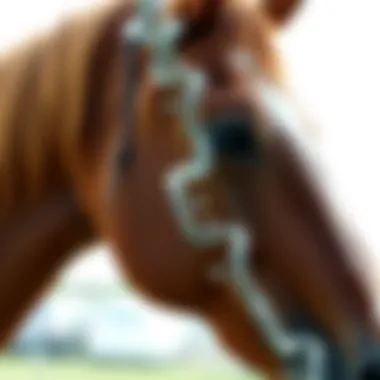Horse Ancestry Testing: A Detailed Overview


Intro
The world of horse ancestry testing has opened a new chapter in equine management and breeding. With the advent of advanced genetic testing technologies, understanding a horse's lineage has become not just possible, but also essential for breeders, owners, and researchers. This comprehensive exploration seeks to shed light on the complexities and implications of horse ancestry testing while revealing how such information could shape decisions in the equine industry.
At its core, horse ancestry testing is a fascinating journey into the genetic makeup of these majestic animals. With a variety of breeds, each possessing distinct characteristics, the quest to trace lineage has practical implications. Breeders, for instance, can make informed choices about mating pairs to enhance desirable traits in offspring. Moreover, understanding a horse's ancestry allows for better management and care, tailored to specific needs derived from genetic backgrounds.
As we navigate through the depths of horse ancestry testing, we will delve into the definitions, scientific principles, and the current research trends that shape the field. Whether you are a dedicated equestrian, an academic in the field of genetics, or simply someone with a keen interest in equine health, this article aims to provide a thorough understanding that meets various levels of expertise.
Preface to Horse Ancestry Testing
In the realm of equine science, understanding horse ancestry testing has become increasingly crucial. As horse enthusiasts, breeders, and owners strive to improve their stock, the insights afforded by ancestry testing can prove invaluable. It offers a window into the genetic makeup of horses, illuminating the paths of their lineage. This practice helps identify ideal breeding pairs and predict traits, enhancing not just the quality of the horse but also the success of breeding programs.
The significance of ancestry testing lies not only in its biological implications but also in its potential economic benefits. With the equine industry constantly evolving, utilizing the most sophisticated tools for health and performance becomes a priority for many. Breeders may face issues like genetic disorders or temperamental inconsistencies, and ancestry testing can help pinpoint these problems before they escalate.
Moreover, understanding a horse's ancestry can shed light on behavioral traits, which can be invaluable for trainers and owners. Horses with certain lineage markers might be predisposed to specific behaviors, and recognizing these tendencies can assist in training and overall management.
Also, as we venture into this exploration, ethical considerations emerge, particularly regarding data privacy and the use of genetic information for breeding decisions. As technology progresses, the need for responsible practices in genomics becomes clearer.
"Knowledge is power, especially in the hands of those committed to the wellness of the equine species."
"Knowledge is power, especially in the hands of those committed to the wellness of the equine species."
The upcoming sections will delve into the historical context of horse ancestry testing, trace the emergence of genetic testing, and explore the scientific underpinnings of this increasingly sophisticated field. We will also evaluate the methodologies used in testing, discuss potential benefits and ethical dilemmas, and highlight real-world applications that showcase the transformative impact of this science on the equine industry.
Scientific Principles of Ancestry Testing
Understanding the scientific principles behind horse ancestry testing is foundational for those seeking to explore the depths of equine genetics. This section aims to provide clarity on how these tests function, the basic concepts of genetics, and the types of genetic markers involved.
Basic Genetics Overview
At the heart of ancestry testing lies an understanding of basic genetics. Every horse, like all organisms, possesses genes that are inherited from their parents. These genes not only dictate physical traits such as coat color and height but also play a critical role in behavioral tendencies and susceptibility to diseases.
Genetics can be boiled down to two main components: genotype and phenotype. The genotype refers to the actual genetic makeup an organism carries, while the phenotype is the observable expression of that genotype. To put it simply, you can think of a genotype as a recipe and the phenotype as the final dish that comes out when you cook. Just as two chefs can produce different versions of the same dish by altering ingredients or methods, two horses can present diverse traits even if they share similar genetic backgrounds.
How DNA Testing Works
So how does DNA testing come into play? The process usually begins with sample collection. Breeders or owners send in a sample—commonly hair or blood— to a laboratory. Once received, the testing facility isolates the DNA and looks for specific sequences that can provide insights into lineage. These sequences are often compared against extensive databases that contain genetic information from various breeds.
A key part of DNA testing is the ability to amplify small quantities of DNA through a technique called Polymerase Chain Reaction (PCR). This allows researchers to identify genetic markers that carry significant information about a horse's ancestry.
The results usually detail ancestry reports, which outline breed composition and potential health risks, allowing the owner to make informed decisions about breeding and care.
Types of Genetic Markers
Genetic markers are the breadcrumbs left along the path of inheritance, guiding researchers in uncovering ancestral ties. There are several types of these markers, each serving a unique purpose:
- Microsatellites: Short, repetitive sequences of DNA that vary greatly among individuals. These markers are valuable for breed identification and parentage verification.
- Single Nucleotide Polymorphisms (SNPs): Variations at a single nucleotide position in the DNA sequence. SNPs are crucial in pinpointing specific traits and disorders. They can also be used to identify potential health issues early.
- Mitochondrial DNA: The DNA located in mitochondria, inherited maternally, which can provide insights into maternal lineage. This type of marker is especially useful for tracing the lineage of particular bloodlines over generations.
Understanding these different markers is essential as they can significantly influence breeding strategies, health management, and the overall quality of a breeding program.
The genetic information garnered from ancestry testing can revolutionize breeding by providing not only records of lineage but also revealing possible hidden traits or diseases.
The genetic information garnered from ancestry testing can revolutionize breeding by providing not only records of lineage but also revealing possible hidden traits or diseases.
In essence, grasping the scientific foundations of horse ancestry testing equips breeders and researchers with the tools needed to finesse their practices, ultimately paving the way for healthier and potentially more successful equines.
Methods of Testing and Analysis
Understanding the methods of testing and analysis in the realm of horse ancestry testing forms a critical bridge between the science of genetics and practical applications in breeding and equine management. This section highlights how robust procedures enhance the accuracy of results, influence breeding decisions, and provide essential insights into genetic predispositions. By grasping these methodologies, we can better appreciate their significance in shaping the future of the equine industry.


Sample Collection Techniques
The first step in horse ancestry testing begins with sample collection, an art and a science rolled into one. The most common samples used are blood, hair, or saliva. Each sample type has its advantages:
- Blood Samples: Often perceived as the gold standard, blood samples are rich in DNA, providing a high yield. However, they require a trained professional for collection, which may not always be convenient for horse owners.
- Hair Samples: Horse hair, especially the mane, holds significant DNA content. Collecting hair is straightforward and less invasive. However, if the hair roots are not included, the DNA quality might be suboptimal.
- Saliva Samples: Cheek swabs have also gained traction recently. They are easy to collect and don’t necessitate the intervention of a veterinarian. Nonetheless, the amount of DNA collected may sometimes be lesser in comparison to blood.
In considering these techniques, the choice often depends on accessibility, the horse’s temperament, and the intended purpose of the testing.
Laboratory Processes
Once samples are collected, they undergo a rigorous laboratory process that can be likened to a recipe in gourmet cooking. Each step is crucial to ensure that the final product, namely, the genetic insights, is accurate and reliable. The laboratory processes typically involve:
- DNA Isolation: The first step is isolating the DNA from the collected samples. This process can vary based on the sample type but generally involves breaking down cell membranes to release the genetic material.
- Amplification: Using polymerase chain reaction (PCR), specific segments of DNA are duplicated to create enough material for analysis. This step is vital for ensuring that even minute amounts of DNA can yield significant results.
- Sequencing and Analysis: The amplified DNA is then sequenced to identify the genetic markers. This sequencing can analyze hundreds of thousands of markers in a single test, providing a detailed glimpse into the genetic makeup of the horse.
This systematic approach in laboratories underscores the significance of technical expertise and sophisticated equipment in producing valid results. The robustness of these laboratory processes directly influences the trust that breeders place in the findings.
Data Interpretation
Having generated data through advanced laboratory techniques, the real challenge lies in data interpretation. This step transforms raw genetic information into actionable insights. Several key facets come into play:
- Comparative Analysis: Samples of horses are often compared against established databases to ascertain lineage and define genetic traits. This process identifies hereditary characteristics and potential vulnerabilities to certain diseases.
- Phenotypic Correlation: Understanding how genetic markers correlate with observable traits (phenotypes) is vital. For instance, certain genes may predispose horses to specific behaviors or physical attributes, which are crucial for breeders aiming for particular traits.
- Clear Reporting: It’s essential that the interpretation of data is conveyed clearly. Genetic reports should be user-friendly, allowing horse owners and breeders to understand implications easily. A good genetic report will not only present findings but also elucidate their significance.
“The true value of genetic data lies not just in the numbers but in the story they tell about each horse.”
“The true value of genetic data lies not just in the numbers but in the story they tell about each horse.”
Interpreting the data accurately can lead to improved breeding strategies, identify potential health issues, and ultimately contribute to the success of horse management practices.
This section ties together a comprehensive understanding of the methods involved in testing and analysis, crucial for anyone engaged in or studying horse breeding and genetics. By learning about the step-by-step processes, from sample collection to data interpretation, stakeholders can make informed choices that impact the longevity and health of equine populations.
Benefits of Horse Ancestry Testing
Horse ancestry testing provides crucial insights into equine genetics, presenting numerous advantages for breeders, owners, and the modern equine industry. By understanding the genetic makeup of horses, stakeholders can make informed decisions that carry long-term implications for health, performance, and overall well-being. The importance of these benefits reaches far beyond mere curiosity; it translates into tangible enhancements in breeding practices and horse management.
Enhancing Breeding Programs
Developing elite breeding programs is no small feat. By utilizing ancestry testing, breeders can glean valuable information about the genetic lineage of their horses. This knowledge helps them prioritize traits that contribute to desirable outcomes, be it speed, strength, or temperament. With data from breed registries, breeders gain clarity on genetic diversity and can better avoid inbreeding, bringing about healthier offspring.
Moreover, by leveraging genetic testing, breeders can target specific breeding goals. For instance, if a horse exhibits exceptional performance traits, DNA analysis may reveal whether these traits have strong heritability. Breeders can then make more strategic matings, heightening the chances of producing progeny that match or exceed the performance of their lineage.
Identifying Genetic Disorders
Another pivotal benefit of horse ancestry testing lies in its ability to uncover underlying genetic disorders that may not be immediately visible. Certain breeds are genetically predisposed to specific health issues. With a comprehensive analysis, breeders and owners can identify carrier status or even prevent common hereditary diseases.
This proactive approach not only improves the overall health of horses but also protects the investments made in these animals. By understanding the genetic risks, owners can tailor management practices and make informed decisions about veterinary care or breeding strategies. For example, knowing a horse carries a gene for a hereditary disease can prompt the owner to opt for careful breeding practices to reduce the risk of passing it on to the next generation.
Understanding Behavioral Traits
Yet another facet of ancestry testing is its contribution to insights into behavioral traits. Horses, like all animals, demonstrate a wide variety of behaviors influenced by their genes. Through genetic testing, owners can gain a clearer picture of their horse's potential behavioral predispositions.
For instance, research is beginning to show links between certain genetic markers and behaviors such as trainability, stress responses, and temperament. This knowledge can prove invaluable for trainers and handlers, allowing them to understand and prepare for the individual needs of each horse. Rather than relying on anecdotal evidence or trial and error, equine professionals can implement more effective training regimes, tailoring approaches to the horse's genetic profile.
"Genetic information serves as a compass, guiding breeders and owners alike toward informed decisions that lay the foundation for healthier, more capable horses."
"Genetic information serves as a compass, guiding breeders and owners alike toward informed decisions that lay the foundation for healthier, more capable horses."
Ethical Considerations
The rise of horse ancestry testing brings forth several ethical considerations that demand attention. This dialogue isn't simply about the technicalities of testing; it intertwines with core issues of privacy, data ownership, and the potential shifts in breeding practices. An in-depth understanding of these elements is crucial as they shape the future landscape of the equine industry.


Privacy and Data Ownership
Privacy in genetic testing is a double-edged sword. On one side, horse owners who submit their animals' DNA for analysis expect a high level of confidentiality regarding their data. This expectation extends to understanding how the results will be used and shared. Key aspects of privacy include:
- Informed Consent: Participants must be fully aware of what they agree to when they provide samples, particularly regarding future testing or research involving their horse.
- Data Management: There are concerns about who owns the results. Is it the owner of the horse, or does the testing company hold the rights? These questions need careful examination to prevent misuse of genetic information.
In recent years, some companies have responded by implementing structured protocols to safeguard data integrity and privacy. They encourage transparency in how data is collected, stored, and utilized, which can enhance trust among consumers. Yet, ongoing vigilance is required to adapt to evolving privacy laws and ethical standards in genetic research.
Use of Genetic Information
The use of genetic information raises pressing ethical questions about its applications in breeding and training. While this information can lead to more informed decisions, it also raises the prospect of inadvertently promoting genetic homogenization. Key points to consider include:
- Responsible Use: Breeders and trainers must use genetic insights judiciously, keeping in mind that certain desired traits might lead to inadvertent consequences, such as a rise in hereditary disorders.
- Diversity Preservation: Emphasis should be placed on maintaining genetic diversity. This not only enhances the health of the population but also enriched the variety of equine characteristics.
As genetic databases grow, they can lead to informed decisions that improve health and performance. However, it is vital to balance these benefits with the need to maintain broader genetic variability.
Impact on Breeding Practices
Shifts in genetic understanding could significantly alter breeding practices in the equine world. The integration of ancestry testing into breeding decision-making invites a host of ethical deliberations. Consider the following impacts:
- Enhanced Selectivity: While knowledge of an animal’s genetic background allows for smarter breeding choices, it also risks discouraging less desirable ancestry. This could lead to a diminished gene pool in the sector.
- Social Equity Issues: Notably, access to ancestry testing technology might not be equal among all breeders. Larger and more affluent breeders may have more resources to exploit genetic information, leading to inequities in breeding outcomes.
"The quest for the perfect equine specimen should never come at the cost of genetic health and diversity."
"The quest for the perfect equine specimen should never come at the cost of genetic health and diversity."
The challenge lies in embracing the advancements that genetic testing offers while ensuring that these tools are applied ethically and equitably across the industry. As we move forward, these ethical considerations remain pivotal in shaping responsible breeding practices and the future direction of horse ancestry testing.
Impact on the Equine Industry
Understanding horse ancestry testing is not just about unraveling the genetic heritage of these majestic animals; it also holds significant implications for the broader equine industry. The intersection of genetics and commerce can reshape breeding practices, improve overall horse health, and guide future research initiatives.
Market Trends
With horse ancestry testing gaining steam, the market is responding in ways that could revolutionize breeding and equine care. A surge in demand for high-quality genetics has led to breeders seeking out tests that provide comprehensive data on lineage. Not too long ago, buying a horse was often more about look and reputation than solid scientific proof of its lineage. However, with advancements in technology, there's a notable shift towards genetics-driven decision making.
- Increased Value: Horses with documented ancestry have considerable market value. Breeders who utilize ancestry tests can justify higher prices for offspring with a strong genetic foundation.
- Consumer Education: Today’s buyers are more informed and are demanding transparency. They want assurances that the horse they’re purchasing has a healthy genetic background. This trend is prompting breeders to adopt testing as a standard practice.
- Shifts in Breeding Practices: As ancestry testing becomes a staple in the industry, there's a tendency towards selecting for traits that test results suggest are favorable, changing the trajectory of horse breeding.
To underscore the importance of this trend, consider the example of Thoroughbred racing where pedigree has always been critical. Recent shifts now incorporate genetic testing to ensure that the horses have the lineage not just on paper but also backed by robust genetic evidence.
Scientific Research Contributions
The implications of horse ancestry testing extend far beyond immediate market benefits; the field also facilitates significant scientific contributions. Genetic testing tools yield data that researchers can utilize to further enhance our understanding of equine biology. These advancements can lead to extraordinary breakthroughs in several areas:
- Disease Prevention: Knowledge gleaned from ancestry testing can reveal predispositions to specific genetic disorders. This allows for targeted breeding efforts to mitigate health issues within certain bloodlines.
- Behavioral Insights: Genes can influence not just physical traits but also behavioral characteristics. Research fueled by ancestry data can unlock insights into why some horses exhibit certain temperaments or trainability.
- Evolutionary Studies: Genetic data can also contribute to the understanding of how equines have evolved over time, with ancestry testing providing a clearer picture of lineage and its correlation with modern traits.
"The gathering of ancestry data is like piecing together a family tree; the more branches you have, the clearer the picture of health and behavior can be."
"The gathering of ancestry data is like piecing together a family tree; the more branches you have, the clearer the picture of health and behavior can be."
Ultimately, the growing reliance on genetic insights could lead to an industry-wide paradigm shift, where decisions are increasingly informed by science rather than tradition alone. It presents a future where both the horse and its human counterparts benefit from a more informed breeding approach, resulting in healthier and more adaptable equine populations.
For further information on equine genetics and advancing research, consider checking resources like Wikipedia and National Center for Biotechnology Information.
As the winds of change sweep through the equine industry, embracing these advancements can pave the way for better breeding practices, promote effective disease management, and enhance the overall welfare of horses globally.
Case Studies
Case studies provide a critical lens through which the practical applications of horse ancestry testing can be examined. These narratives offer real-world examples that underscore the relevance of genetic insights in the equine world. By highlighting how breeders and owners have effectively utilized ancestry testing, we can appreciate its true potential as a tool for making informed decisions about horse breeding and management.


Some advantages of exploring case studies include:
- Practical Applicability: They show how theory translates into tangible results.
- Diverse Scenarios: Different breeds and contexts can reveal unique insights into genetic traits.
- Learning Opportunities: Failures and successes both offer lessons that can enhance future practices.
Successful Ancestry Testing Applications
One compelling example of successful ancestry testing can be seen in the thoroughbred racing industry. Breeders have greatly benefited from genetic testing to identify horses with desirable traits that enhance performance. For instance, a well-known racehorse recently had its DNA tested to confirm its lineage, which traced back to a legendary champion. This documentation not only increased its value but also provided the breeder with a wealth of data, enabling informed decisions regarding mating selections.
In addition, various equine rescue organizations have used ancestry testing to ascertain the genetic health and behavior predictions of horses in their care. For example, when a rescue found a neglected mare with a mysterious background, conducting a genetic test revealed its lineage to a line associated with calm temperaments. This information helped trainers tailor their approach for rehabilitation, easing the mare into riding and socialization, ultimately leading to a successful adoption.
Lessons Learned from Genetic Insights
Analyzing case studies sheds light on important lessons learned from genetic insights. One of the most significant lessons is the importance of understanding genetic diversity. A case involving a breed known for its high incidence of hereditary diseases exemplifies this point. Breeding programs that failed to account for genetic variability encountered increased occurrences of disorders. In contrast, programs that utilized ancestry testing to monitor genetic diversity saw a reduction in overall health issues within their populations.
Another key takeaway revolves around the significance of integrating genetic insights with traditional breeding strategies. A notable instance involved a drive to create a program combining selective breeding with ancestry testing data. Breeders who embraced this hybrid approach reported not only improved performance benchmarks but also better, healthier foals.
"The adoption of genetic testing is reshaping the landscape of the equine industry, offering a pathway towards healthier horses and improved breeding outcomes."
"The adoption of genetic testing is reshaping the landscape of the equine industry, offering a pathway towards healthier horses and improved breeding outcomes."
In essence, case studies serve as a bridge linking the theoretical world of genetics and the practical realities of equine management. They illuminate the nuances and complexities involved in ancestry testing, thereby enriching our understanding of its applications and implications for the future.
Future Directions in Equine Genetics
As the field of equine genetics continues to evolve, understanding the future directions of horse ancestry testing becomes essential for breeders, researchers, and horse enthusiasts alike. The potential advancements in technology, paired with new discoveries, pave the way for deeper insights into genetic lineages. This section explores how innovative developments can transform not only breeding practices but also the overall health and performance of horses.
Advancements in Technology
The rapid progression of technology is reshaping horse ancestry testing. One key advancement is the use of next-generation sequencing (NGS). This technology allows scientists to examine the equine genome with an unprecedented level of detail, making it possible to identify genetic markers associated with specific traits.
Some notable advancements include:
- High-throughput sequencing: This technique can process thousands of samples at once, significantly reducing the time and costs associated with genetic testing.
- Bioinformatics tools: Improved software enables better analysis of genetic data, providing clearer insights into ancestry and lineage. The rise of machine learning techniques can sift through massive datasets to identify patterns that traditional statistical methods may miss.
- Wearable tech: Devices that monitor horse health and performance could be integrated with genetic data, offering a complete picture of how genetic traits manifest in real-world performance.
These technologies don't just enhance accuracy. They also make testing more accessible, allowing smaller breeding operations to benefit from data that was once only available to major players in the equine industry. This democratization of data fosters innovation among various stakeholders—from researchers looking for answers about genetic disorders to breeders aiming for optimal pairings.
Potential for New Discoveries
With advancements come new opportunities for discoveries that could shatter existing paradigms in equine genetics. The integration of ancestry testing in veterinary practices may revolutionize how we approach health and disease management.
Consider the following possibilities:
- Identification of genetic disorders: Enhanced sequencing technologies reveal not just the lineage but the health profile of a horse. Breeders can make informed decisions to minimize the transmission of hereditary diseases.
- Behavioral genetics: Future studies might uncover the genetic basis of behavioral traits, leading to better training and care methods tailored to individual horses.
- Conservation efforts: By understanding genetic diversity, conservationists can make informed decisions regarding endangered equine breeds, promoting sustainable breeding practices that preserve genetic health.
"The future of equine genetics lies in our ability to bridge traditional knowledge with cutting-edge technology, unlocking the door to a world where we can predict and enhance the capabilities of our horses."
"The future of equine genetics lies in our ability to bridge traditional knowledge with cutting-edge technology, unlocking the door to a world where we can predict and enhance the capabilities of our horses."
As researchers delve deeper into these topics, the equine community can anticipate transformative advancements that not only enhance breeding strategies but also improve the overall well-being of horses. The harmony between tradition and innovation will be key in crafting a future where horses are understood and nurtured to their full potential.
Culmination
The conclusion of this exploration into horse ancestry testing encapsulates the essence of understanding genetic lineage and its various implications in the equine realm. As the curtain falls on this discussion, it is important to reflect on the manifold aspects that make genetic testing not just a scientific tool but a bridge connecting equine history and modern breeding practices. The integration of ancestry testing into the world of horses signifies a notable evolution in how breeders, owners, and researchers perceive and manage their equine companions.
Summary of Key Findings
As we sift through the crucial findings detailed throughout this article, a few stand out prominently:
- Genetic Insights Matter: Knowledge gained from ancestry testing empowers breeders to make informed decisions that enhance their breeding programs, pinpoint genetic predispositions and mitigate the risks of hereditary diseases. It brings a nuanced approach to maintaining breed integrity and improving overall equine fitness.
- Practical Implications: The practical applications extend to understanding not just physical traits but behavioral tendencies as well. This understanding is vital in training, managing, and interacting with horses, leading to better outcomes for both horses and handlers.
- Ethical Dimensions: As technology progresses, the ethical considerations surrounding privacy and the ownership of genetic information must be front and center. Breeders and owners need to navigate these waters carefully to uphold trust while exploiting the benefits of genetic insights.
In essence, the intersection of genetics and equine management lays fertile ground for advancements that could reshape the industry. The revelations drawn from genetic testing offer not only clarity but also a path forward—one that respects tradition while embracing innovation.
The Ongoing Journey of Understanding
The dialogue surrounding horse ancestry testing is far from static; it is an evolving narrative that thrives on continued research and discovery. As advancements in technology unlock new layers of understanding, several key points merit attention:
- Technological Innovations: The landscape of DNA analysis is constantly shifting. New technologies, such as CRISPR and advanced sequencing methods, may open avenues for deeper insights into equine genetics, leading to breakthroughs that reshape our current understanding.
- Community Engagement: Engaging with the broader equine community, from researchers to casual horse owners, ensures that findings are disseminated effectively and used responsibly. Collaboration can enhance study designs and encourage a more inclusive approach to the field.
- Implications for Future Generations: The knowledge gained through ancestry testing not only benefits present horses but also sets a precedent for future generations. As we learn more, decisions made today can positively impact equine genetics down the line, promoting healthier, more robust breeds for years to come.







